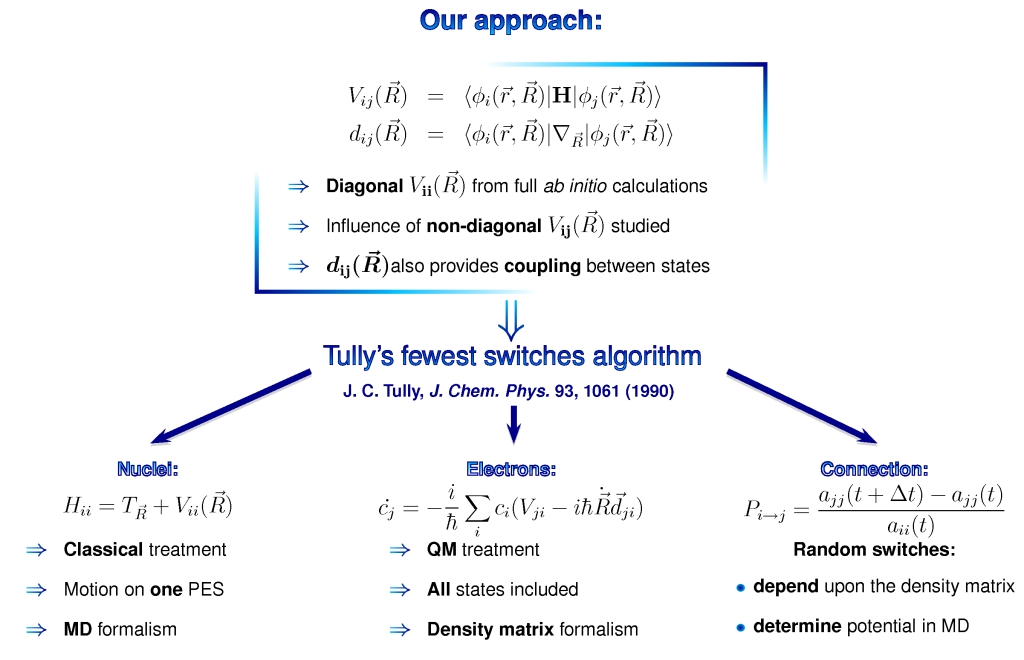Non-adiabatic processes
The main challenge when describing electronically non-adiabatic molecule surface processes is the breakdown of the Born-Oppenheimer approximation. As a consequence exited states have to be included into the simulations explicitly and the dynamics of the nuclei and the electrons must be treated on the same time scale. Nevertheless high accuracy is demanded and the use of ab initio techniques is indicated: Conventional density functional theory (DFT) methods are not appropriate for this tasks, as they do not yield reliable electronically excited states. Hence one has to use extended DFT methods such as time dependent DFT (TD-DFT), DFT within the GW approximation or quantum chemistry methods. In addition the description of these processes has to be as realistic as possible to give reliable results. Therefore as many dimensions and as many electronic states as relevant must be included in the simulations. Furthermore a sufficient number of trajectories is needed for statistical reasons to calculate reliable reaction probabilities.
This leads to a tremendous numerical effort.

Our approach relies on Tully's fewest switches algorithm[1]: We obtain the potential energy surfaces (PES) from ab initio calculations and use them to describe these processes in a mixed quantum classical (MQC) framework: So the dynamics of the nuclei is described in a classical molecular dynamics (MD) like formalism on one PES at a time. The electrons are treated quantum mechanically in a density matrix formalism, thus giving occupation probabilities for each electronic state. Now nuclear and electronic motion are linked together by a surface hopping method: Random state transitions, also called switches, which depend upon the electronic occupation probabilities, determine the PES the nuclei are moving on. Coupling between different states is controlled both by the non-adiabatic coupling vector and the non-diagonal potential matrix elements. Since these coupling parameters are not easy to obtain from ab initio methods, they are often treated as adjustable parameters. Their functional dependence and influence onto the results is also studied in my research.
Ongoing projects:
Concluded projects and research highlights:
- Photo-induced desorption of I from KI(100):
- First many-state simulations:
- up to 13 electronic states included
- full ab initio PESs
- Qualitative reproduction of experimental data
- Publication:
- Christian Carbogno, Axel Groß and Michael Rohlfing, Ab initio investigation of the laser induced desorption of iodine from KI(100) , Appl. Phys. A, subm. July 2006 .
[Preprint (PS), Preprint (PDF)]
- Christian Carbogno, Axel Groß and Michael Rohlfing, Ab initio investigation of the laser induced desorption of iodine from KI(100) , Appl. Phys. A, subm. July 2006 .
- First many-state simulations:
- Scattering of iodine from diamond:
- Proof of concept:
Influence of- different basis sets
- dimensionality
- coupling
- Simulations from one up to four degrees of freedom led to qualitative agreement with full quantum mechanics and experiment
- Publications:
- C. Bach, and A. Gross,
Faraday Discuss. 117, 99(2000) - C. Bach, and A. Gross,
J. Chem. Phys. 114, 6396(2001) - C. Bach, C. Carbogno, and A. Groß,
Israel J. Chem. 45, 46(2005)
- C. Bach, and A. Gross,
- Proof of concept:
- Scattering of NO from NiO (by Dr. Christian Bach):
- Continuous excitations on metal surfaces:
introduction of the optical potential - Publications:
- C. Bach, T. Kluener, and A. Gross,
Chem. Phys. Lett. 376, 424(2003) - C. Bach, T. Kluener, and A. Gross,
Appl. Phys. A 78, 231(2004)
- C. Bach, T. Kluener, and A. Gross,
- Continuous excitations on metal surfaces:
